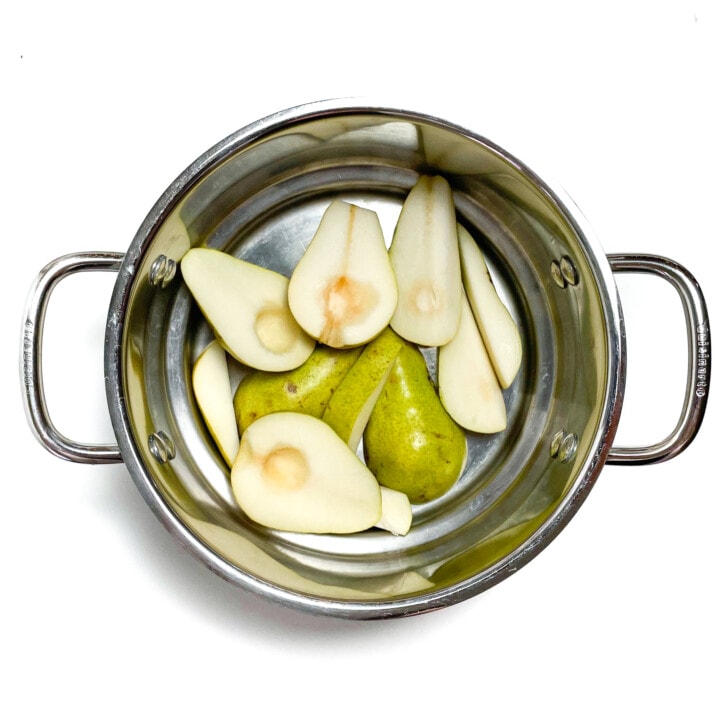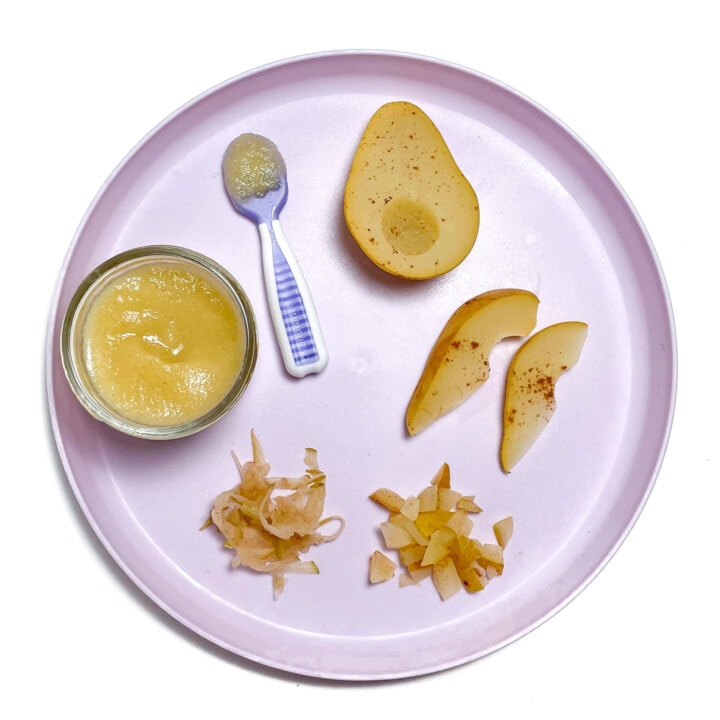Pear for Baby-Led Weaning
Pears are a great first finger food for baby-led weaning. You can serve them as a baby food puree on a self-feeding spoon, cooked and in half or large slices for baby-led weaning, or cooked and chopped for a finger food. Plus, this guide has nutritional benefits of pears for your baby, FAQs, 3 ways to prepare pears, feeding tips, and so much more! Great for 6 months and up!
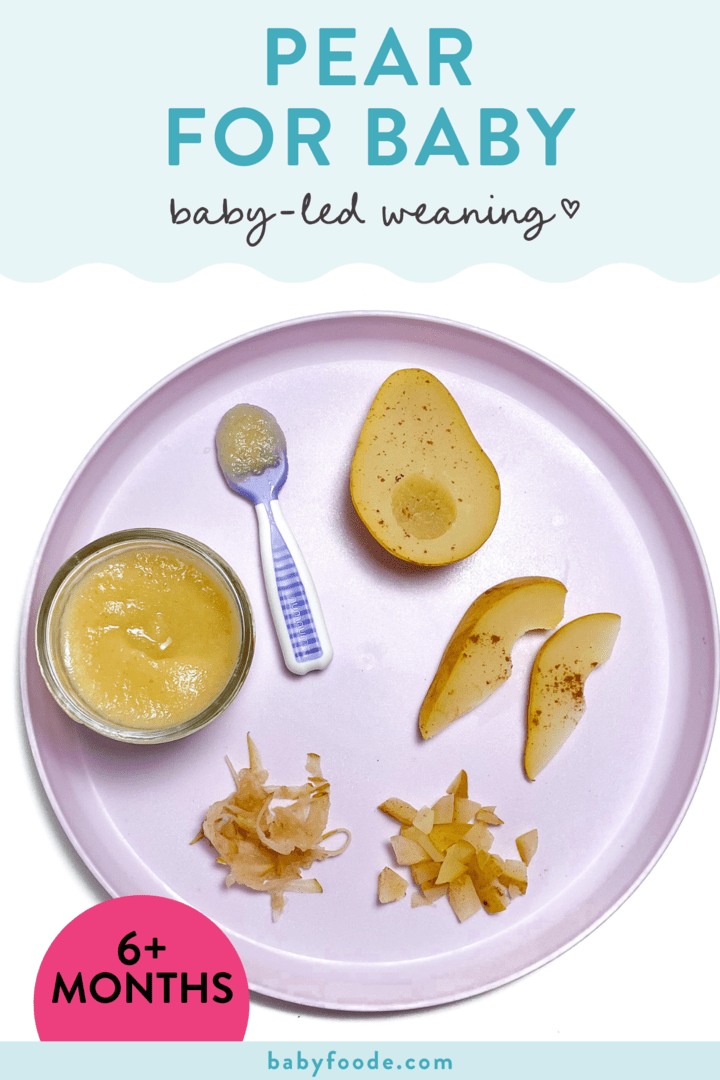
Medically reviewed and co-written by Jamie Johnson, Registered Dietitian Nutritionist (RDN), and Lauren Braaten, Pediatric Occupational Therapist (OT).
Pear for BLW
If you are looking for information on how to feed pears to your baby, then this is the place for you!
Pears are full of essential nutrients and are a great food for your baby! Plus, pears are super easy to make into finger foods for baby-led weaning! 🖐
Below 👇 you will find 3 of my favorite ways to serve pears to your baby!
First time making homemade baby food? Then, I would suggest that you start by reading my very in-depth Complete Guide to Baby-Led Weaning – which covers what exactly is baby-led weaning, to every parent’s concern of baby-led weaning and choking, this guide goes over it all. I will also share how to know when baby is ready for BLW, the top 10 best first foods, a helpful sample blw feeding schedule, helpful tools to have on hand, and much much more!
You can also check out my best-selling cookbook for even more information and recipes!
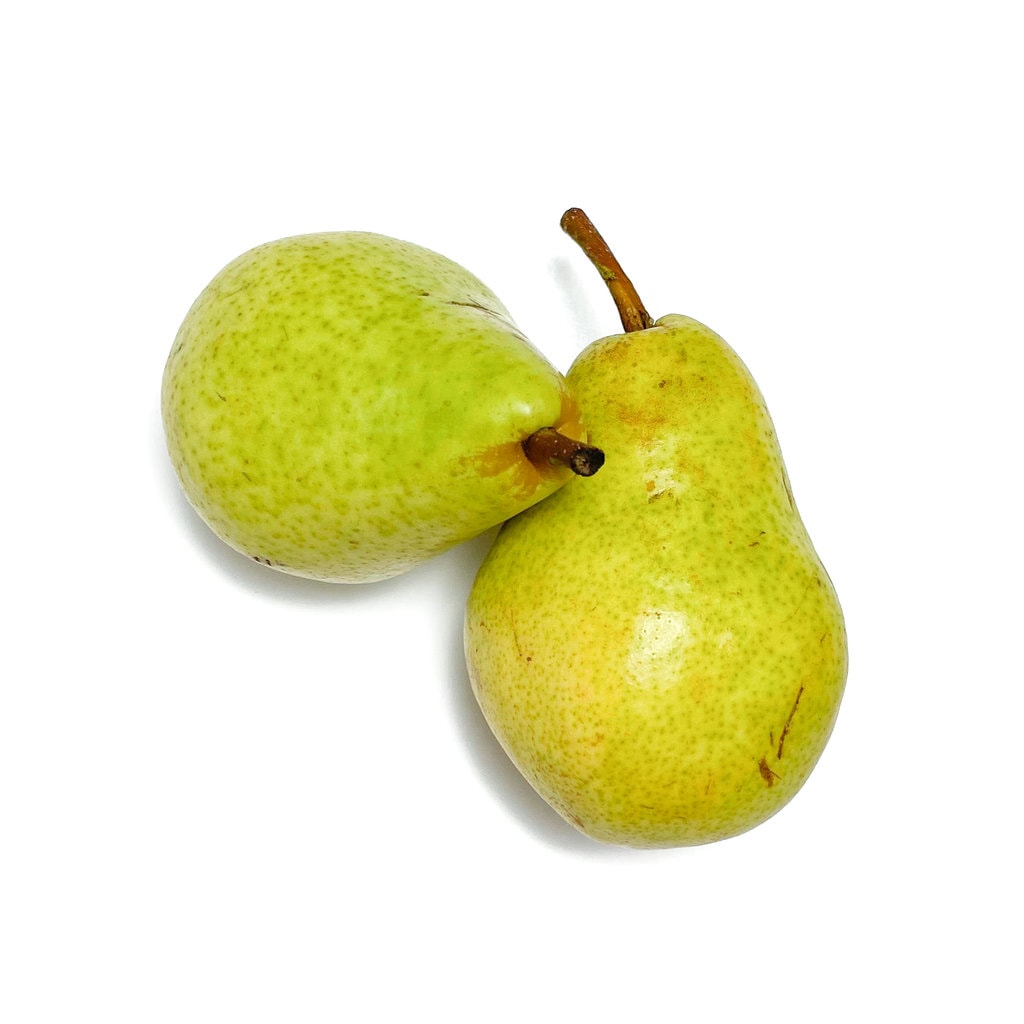
Reasons to Love Pears for BLW
- Great for baby-led weaning – 6+ months
- Also great for the finger food stage – 9+ months
- Full of essential nutrients for baby
- Different ways for baby to eat – spoon-fed or self-feed
- Easy to make – minimal prep work required
Health Benefits of Pears
There are tons of varieties of pears, and all are nutritious, so offer different types to give your baby different tastes and textures.
- Good source of immune-boosting vitamin C.
- Great source of fiber, to help with digestion and improves constipation.
- Provide vitamin K to help strengthen bones.
Types of Pears
Feel free to use any pear you prefer – Bosc Pear, Taylor’s Gold Pear, Bartlett pears, Anjous Pear, Asian Pear or Comice.
Spices to Add
Adding spices to your baby’s foods is a great way to introduce more complex flavors at an early age. Some great spices and herbs to add to cooked pears are a pinch of allspice, anise, cinnamon, cardamom, cloves, ginger, mint, nutmeg, rosemary, or thyme.
Frequently Asked Questions
Pears can 100% be your baby’s first food if you want it to be. It is recommended to wait to introduce the top eight allergen foods to your baby once a few other well-tolerated foods have been introduced, but otherwise, foods can be introduced in any order, so choose whatever you are most excited for your baby to have.
No, pears are not a common allergen; however, as with any food, start with a small portion and be aware of any signs that might be an allergic reaction after introducing it.
As with any food, you should always supervise your baby while they are eating. To minimize choking risks, cook pears until they are completely soft. Raw, unripe pears can be a choking hazard, so either cook them or serve them in paper-thin slices once your baby is old enough to grasp them.
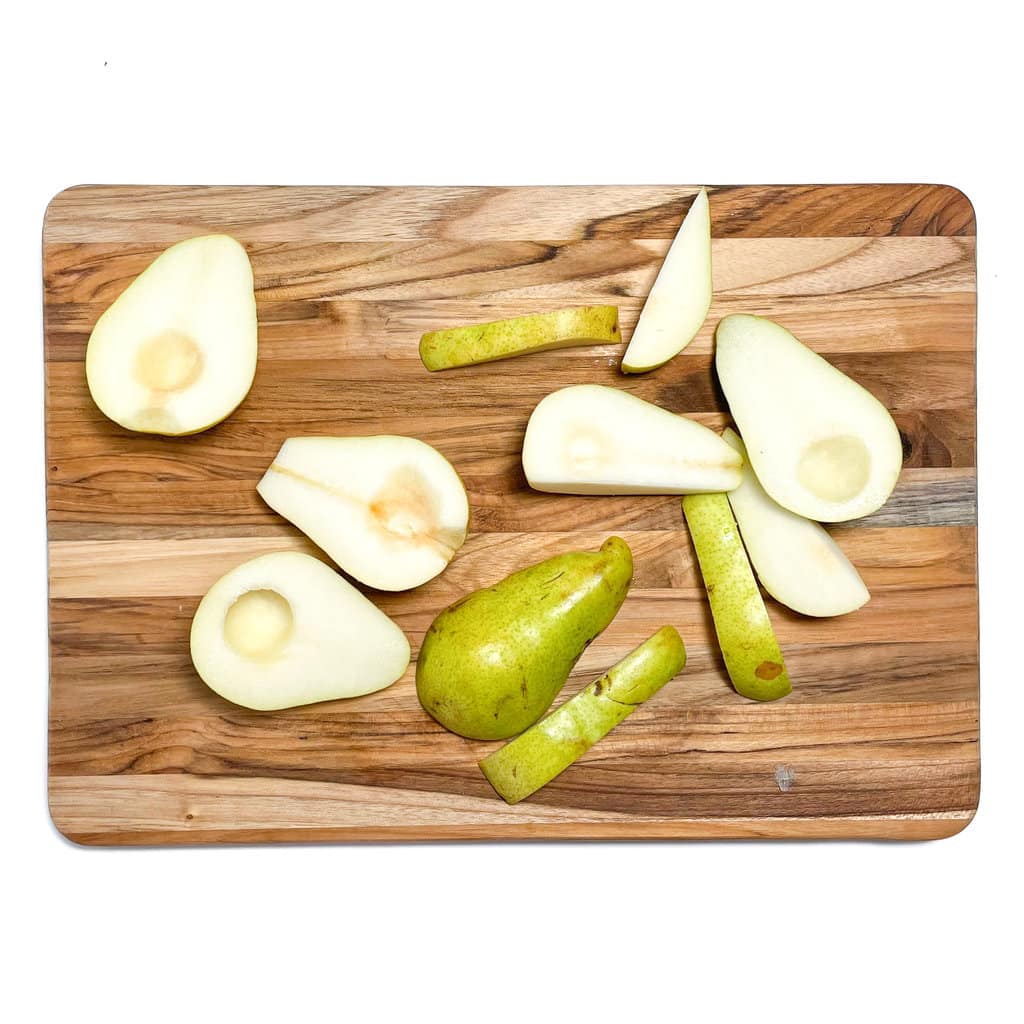
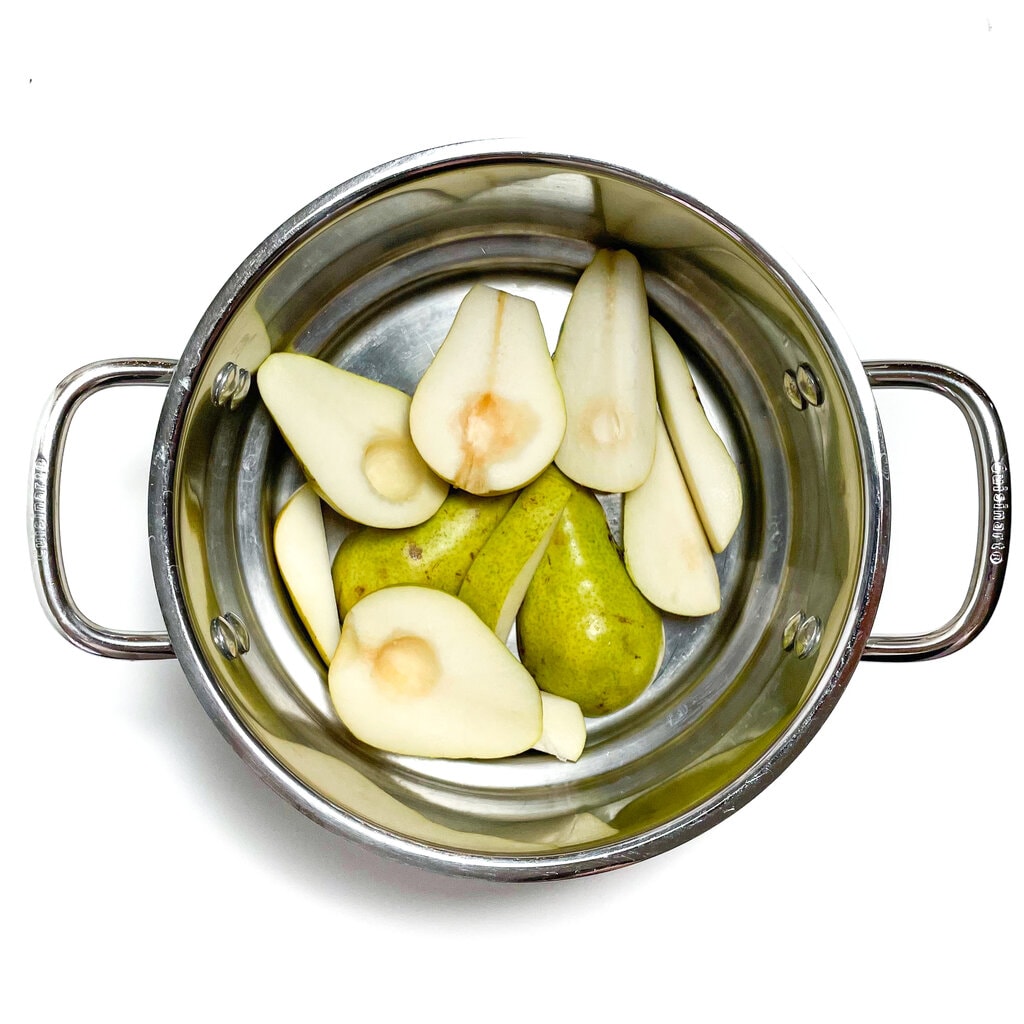
How to Prepare Pears for Baby-Led Weaning
There are several different ways to prepare pears for your baby. Here are some of our favorite ways:
Steamed
In a medium pot, bring 2 inches of water to a boil. Add the pears to a steamer basket, cover, and cook over medium heat for 8 minutes or until fork tender. Let cool slightly.
Simmered
Place pears and 2 tablespoons of water in a medium pot. Turn heat to medium and simmer for 10-15 minutes or until pears are tender.
Sauteed
Melt 1 tablespoon of unsalted butter in a large skillet over medium heat. Add the pears and about 1/2 cup of water. Simmer for 8 minutes, until the water has evaporated and the pears turn golden brown, stirring occasionally.
Pear Puree: You can offer purees and still allow your baby to lead the way with self-feeding by offering the puree on a self-feeding spoon, by placing a few spoonfuls of the puree directly on the tray or in a bowl for your baby to dip their fingers into, or you can even use the puree as a dip for solid foods such a banana or piece of toast.
Helpful Tools
Here are some products that help you make and serve pears to your baby even easier! To find even more products that I love, make sure to check out my online shop.
- Highchair
- Saucepans
- Steamer Insert with lid
- Easy to hold fork and spoon
- GOOtensils
- Bowl or Sectioned plate
- Open lid cup
- Bib with catch pocket
- Sleeved bib
- Splat mat to cover the floor
Baby-Led Weaning Feeding Tips
- It may seem counterintuitive, but offering younger babies a larger piece of pear, such as cooked halves or thick slices will actually reduce choking risks, as they are less likely to break off a larger piece that’s difficult to manage. Serving larger pieces is also easier for younger babies (6-9 months) to grasp while eating.
- Cooked pears can sometimes be slippery, so try rolling in finely ground baby cereal, hemp seeds, ground flaxseeds, or finely shredded coconut to help give your baby a better grasp.
- Pureed and mashed pears are also great for adding to yogurt, oatmeal, and other pureed fruits and veggies.
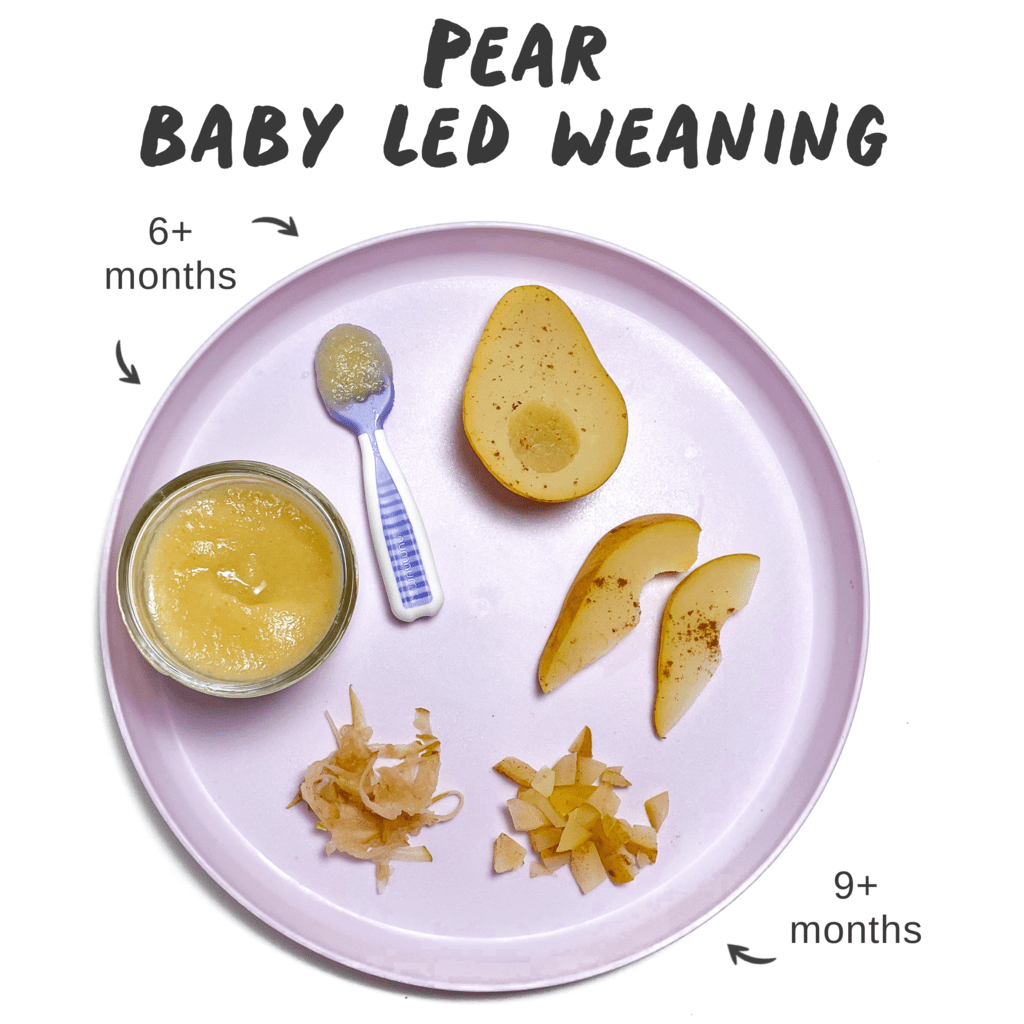
How to Serve Pears for Baby-Led Weaning
Pears can be a choking hazard for your baby, regardless if you are doing baby-led weaning starting at 6 months or during the finger foods stage at 9 months, so it is important to cook and serve them properly.
Cooked in Half, Thick Slice or a Puree (6+ months): These forms will be easier for your baby to pick up at this age. If they are ripe enough, you may not even need to cook them as long as they are soft. Make sure to remove the core before serving halves, so your baby does not eat the seeds. You can offer purees and still allow your baby to lead the way with self-feeding by placing some spoonfuls directly on your baby’s tray or bowl to let them explore on their own, or you can hand them a pre-loaded self-feeding spoon.
Cooked in Chunks or Grated (9+ months): Baby starts to develop the pincer grasp around this age, so serving chopped pieces or grated will help give them practice. Continue to cook them until soft.
Uncooked in Thin Slices, Bite-Sized or Whole Fruit (12+ months): If you haven’t already, offer these with the skin on for more antioxidants and to give your toddler practice with chewing the texture of the peel.
Storage
You can store these cooked pears in an air-tight container in the fridge for up to 3 days.
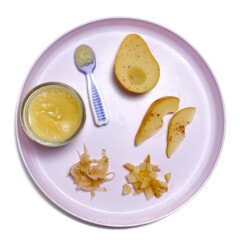
Get the recipe: Pear for Baby-Led Weaning
Ingredients
- 2 pears, cored, and cut in half or long strips
- pinch cinnamon
Instructions
- In a medium saucepan, bring 2" of water to a boil over high heat. Add a steamer basket and add the pears, cover and cook for 10-12 minutes or until tender when pricked with a fork. Remove from heat and let cool.
- Pinch a little cinnamon (if using) on the pears and toss, then cut in an age-appropriate way.
Notes
- Place a few spoonfuls of purees directly on the tray or in a bowl for your baby to dip fingers into. Model how to dip your fingers into the puree and bring them to your mouth, to taste some.
- Offer your baby a pre-loaded self-feeding utensil and hold it out for them to grasp or set on their tray.
- Use a solid food as a dipper. You can also offer a soft stick-shaped piece of food, such as a soft roasted carrot or bread lightly toasted and cut into strips to dip into the puree.
Did you make this recipe?
Tag @babyfoode on Instagram and hashtag it #babyfoode!

